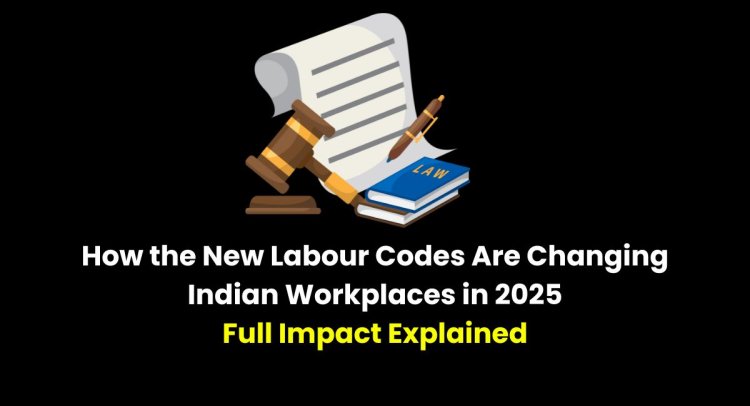India’s four New Labour Codes have started reshaping payrolls, hiring practices, social security, and compliance across the country. As of November 2025, most states have rolled out at least partial rules, and the transition from the old 29 laws to this unified system is now unavoidable for every employer and HR team.
This blog breaks down the real on-ground effects, who wins, who needs to worry, and what you must do right now to stay compliant.
Quick Navigation to In-Depth Guides
- Complete Overview of the Four New Labour Codes
- 2025 State-wise Implementation Status & Rules
- Top 25 Must-Know Highlights of New Labour Codes
- Full List of All Statutory & Compliance Changes
- Penalties, Fines & Consequences of Non-Compliance
- New Labour Codes FAQs – Updated November 2025
1. The Biggest Compliance Relief in Decades
The old system forced companies to maintain dozens of registers, file separate returns under different laws, and display countless notices. The new codes change everything:
- 20+ physical registers reduced to one unified digital register
- Multiple annual returns merged into one single return
- Separate EPF, ESI, and gratuity challans replaced by one consolidated payment
- 50+ wall posters and notices now just one consolidated notice (can be uploaded online)
HR managers in mid-sized companies are already reporting 40-60% less time spent on statutory paperwork.
2. What Employers Gain: Flexibility That Actually Matters
| Area | Old Threshold | New Threshold | Practical Benefit |
|---|---|---|---|
| Standing Orders | 100 workers | 300 workers | Thousands of factories and offices freed from certification hassle |
| Layoff/Retrenchment permission | Above 100 workers | Above 300 workers | Faster restructuring and closures |
| Contract labour licensing | 20 workers | 50 workers | Less paperwork for principal employers |
| Fixed-Term Employment | Grey area | Fully legal with full benefits | Easy seasonal and project hiring |
Multi-state companies finally get uniform definitions of “wages,” “worker,” and “establishment,” ending years of confusion.
3. How Workers and Gig Economy Employees Benefit
For the first time, platform workers (delivery partners, cab drivers, freelancers on Upwork-style sites) and unorganized sector workers are officially recognized.
Key wins for employees:
- No salary ceiling for bonus eligibility (earlier capped at ₹21,000)
- Maximum 50% deduction from wages
- Double overtime pay across all industries
- Gratuity for fixed-term employees on pro-rata basis
- Free annual health check-ups in larger establishments
- Women permitted to work in all roles with proper safety measures
- ESI and provident fund extended to gig workers (aggregators contribute 1-2% of turnover)
4. Critical Payroll and Contract Changes You Cannot Ignore
- Wages must be at least 50% of CTC (bonus, HRA, conveyance now excluded from “wages” definition)
- Cash salary payment largely banned; must go through bank transfer
- Every establishment with 10+ workers needs a Grievance Redressal Committee
- Internal Committee (POSH) mandatory even for smaller units in many states
- Offer letters and contracts must mention fixed-term clauses clearly
5. Penalties Are Now Serious
| Violation | Fine | Possible Jail Term |
|---|---|---|
| Delayed wages | ₹50,000 to ₹1 lakh | Up to 3 months |
| Social security default | Up to ₹3 lakh | Up to 1 year |
| Fatal safety violation | Up to ₹5 lakh | Up to 2 years |
| Repeat offences | Double penalty + license cancellation risk |
6. Where India Stands in November 2025
Fully implemented: Uttar Pradesh, Gujarat, Haryana, Karnataka, Bihar, Madhya Pradesh, Uttarakhand, Odisha Partial rules notified: Maharashtra, Tamil Nadu, Rajasthan, Punjab Still pending full rollout: West Bengal, Kerala
Your 2025-26 Compliance Checklist
- Run a payroll audit for the 50% wages rule
- Register gig workers on the e-Shram portal where required
- Upgrade your HRMS for unified return filing
- Revise appointment letters and fixed-term contracts
- Train managers on the new strike/lockout notice rules
- Switch to single register format immediately
The New Labour Codes are not just another law; they are a complete reset of how India hires, pays, and protects its 500+ million workforce.
Companies that treat this as a one-time update will thrive. Those who ignore it will face audits, fines, and unhappy employees.
Start today. Explore the complete resource hub here: https://digiliance.in/new-labour-codes
Got a specific scenario? Check the updated FAQ section or share your question below; we reply to every comment.






